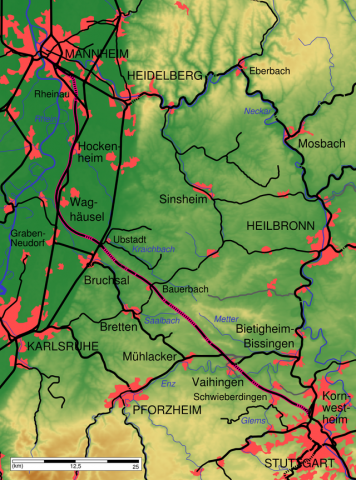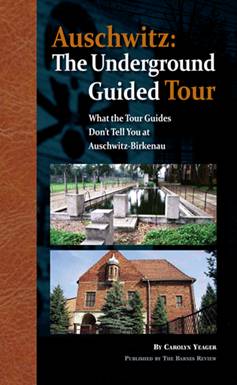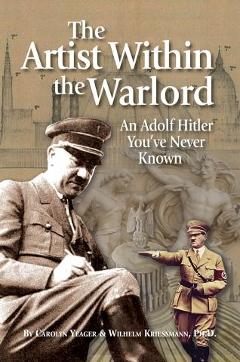My Ancestry
Here is a brief version of my ancestry from the research and compilation by Alf Kuehrt of Nuremberg, Germany for the publication Famlienbuch Sanktanna which he updates every year.
There are 363 family names in the current (2014) 2-volume book, all but 62 of them German. Kuehrt devised a numbering system that allows one to easily find the parents and marriage partner of each person born in Sanktanna, thereby one can discover all the inner-family connections, and maybe a few surprises!
I would like to take my ancestry further back in Germany. A majority of the first families to arrive in Sanktanna (St. Anna) came from the Kraichgau in Baden, a fertile area between Heidelberg and Stuttgart. The Reck family did come from Bauerbach in the heart of the Kraichgau, which is north-northwest of Stuttgart. Enlarge map. Please check out my radio program "In Praise of My Ancestors". I hope to find out more still about my German roots whom, I am pretty confident from the information I have, all traveled to Sanktanna from the Kraichgau or very close nearby areas in Baden. The names of these men and women going back 6 to 7 generations is enough to show that I am German through and through. Following these genealogical lists from my grandparents back, you will find a little bit about the German town of Sanktanna, written by Herr Kuehrt.
Subject: Carolyn E. Yeager
PARENTS: Stephen A. and Barbara J. (Schillinger) Yeager (both born in Illinois, USA)
Stephen's Parents (my grandparents}
Steve Yeager (born Stefan Jäger, 1890) and Barbara Anna Schmidt (born 1891) in Sanktanna, Hungary, a German-settled village. They married in 1907 in Illinois.
Further Jäger line
Stefan Jäger (b1855) married Theresia Bleiziffer in 1879 (2nd gdpts)
Josef Jäger (b1824) married Katharina Müller in 1848 (3rd gdpts)
Johann Jäger (b1798) married Barbara Englehardt in 1823 (4th gdpts)
Johann Jäger (b1769) married 1) Maria Elisabeth Göttler in 1792; married 2) Katharina Raab (mother of Johann Jr) in 1796 (5th gdpt)
Further Schmidt line
Michael Schmidt (b1859) married Theresia Totterer in 1883 (2nd gdpt)
Anton Schmidt (b1833) married Theresia Emeneth in 1852 (3rd gdpt)
Michael Schmidt (b1804) married Katharina Scham in 1824 (4th gdpt)
Josef Schmidt (b1784) married Franziska Abfalter in 1803 (5th gdpt)
Sebastian Schmidt (b1740) married Rosalia ? (b1738) (6th gdpt)
Barbara's Parents (my grandparents)
Anton Schillinger (born 1883) and Barbara Reck (born 1884) in Sanktanna, Hungary. They married in 1906 in Illinois.
Further Schillinger line
Anton Schillinger (b1844) married Anna Bleiziffer in 1871 (2nd gdpt)
Franz Schillinger (b1812) married Anna Daminger in 1835 (3rd gdpt)
Josef Schillinger(b1774) married Rosalia Brunner in 1797 (4th gdpt)
Franz Schillinger (b1740) married Katharina Vogel in 1767 (5th gdpt)
Further Reck line
August Reck (b1853) married Barbara Hell in 1882 (2nd gdpt)
Franz Reck (born 1813) married 1) Anna Eckstein in ?; 2) Theresia Schauer (mother of August) in 1852 (3rd gdpt)
Andreas Reck (b1764 in Bauerbach, Germany) married Maria Katharina Silbereis in 1791 in Sanktanna (4th gdpt)
Johann Georg Reck (b1718 in Bauerbach, Baden, Germany) married Barbara Sturn in 1741 in Bauerbach. (5th gdpt) Barbara Sturn is my oldest known female ancestor; she was born in 1722.
A bit of history of Sanktanna (St. Anna)
The settlement in the small hamlet “Komlos” (Hungarian for hop village), 21 km north of Arad, wasn’t begun by the imperial Viennese court, but at the instigation of the Hungarian baron Jakab Bibics, the landed proprietor of the whole region. “Komlos” soon became “Old-Sanktanna” (Hungarian).
Next to it, on the waste land “Fako” (Hungarian for pale colours) originated its twin settlement, “New-Sanktanna” (German). The name Sanktanna goes back to an ordinance of the [Austrian] empress Maria Theresia, queen of Hungary.
The village grounds were laid out in the structure of a chessboard village which couldn’t have been more beautiful and more regular. One imagines a square with 6 times 6 dice. That would be 36 house squares and one takes 2 dice out in the middle, making room for the big market-place. An original Viennese military plan can’t be excluded.
Komlos belonged to the imperial military frontier until 1741/42, which had protected the Tisza-Mureş-region since the Peace of Karlowitz (1699).
Sanktanna originated in about 1742 in a time of change: the end of the military frontier, the breakdown of the county Arad and Zarand, the constitution of the local Hungarian nobility administration.
One imagines: fallow land, puszta (Great Hungarian Plain grassland) countryside, several dozen houses – and something uncommon: the grammar school building with a convent of the Piarist order, a complex which surrounded the church in the form of a horseshoe. Baron Bibics had summoned the order to Sanktanna, which took up its activity already in 1751.
The new settlers weren’t free farmers at all. They were rather living inventory of the noble lords of the manor Bibics and Fekete, and thus robbed of freedom of movement. There were complaints to Vienna (1752), escape attempts (1763) into the freer Banat—where the 2nd big Swabian emigration began—but people were brought back by force. They had to do compulsory labour and only through their diligence could they later buy themselves free and buy land. [A real swindle -cy]
There came to be more and more craftsmen, which enabled them to free themselves from the compulsory labour. An evidence of an early progress was the granting of the market rights by the empress Maria Theresia and the foundation of the first guild of the bootmaker in Arad county.
On 8 May 1858 1,256 houses fell victim to a village conflagration. The church burned out, as well, and buried people under it. The building of the former Piarist grammar school, which was known as “earl’s house”, suffered grave damages, in the same way the so-called “Urbariushaus” (today German home for the aged). With material assistance of the Catholic office of Buda and Großwardein, today’s church, the greatest of the region, was constructed and opened in 1868.
On Jakob Hillier's initiative, the state-subsidized mutual civic school was established in 1894. Hungarian was the general teaching language, German became the “foreign language.” In the Hungary at that time this language order was legally ordered.
Nobody wanted the “Antoni-War” in January 1899. After all, perpetrators and victims were native people. The farmer's wives of the poor rose up because the big farmers even decided about the common pasture-land and wanted to till up the pasture. Six people died, some were captured and there was a trial.
When after 1900 Hungarian was the fixed language for the educated, the Frankish-Swabian dialect remained perfectly intact.
In November 1918 the men returned home from the 1st World War—defeated. About 100 stayed anywhere they could in Galicia, at the Isonzo or in the Dolomites. At home, the Spanish flu raged and within a few weeks carried off almost more people than the four-year-long war.
The end of the monarchy and of the traditional order came. The new states of Hungary, Romania and Yugoslavia were born. After the peace treaty of Trianon in 1920 Sanktanna became a part of Romania. ~written by Alf Kuehrt
From Wikipedia: Germans of Hungary
The third, largest wave of German-speaking immigrants into Hungary occurred due to a deliberate settlement policy of the Habsburg government after the expulsion of the Ottoman Empire from Hungarian territory. Between 1711 and 1780, German-speaking settlers from Southern Germany, Austria, and Saxony immigrated to the regions of Southwest Hungary, Buda, Banat and Szatmár County. [Sanktanna was north of the region known as the Banat. The city of Arad is just outside the Banat border to the north, and Sanktanna is north of Arad. See map on this page -cy] This influx of immigrants helped to bring economic recovery and cultural distinction to these regions. At the end of the 18th century, the Kingdom of Hungary contained over one million German-speaking residents. During this time, a flourishing German-speaking culture could be found in the kingdom, with German-language literary works, newspapers, and magazines being produced. A German language theater also operated in the kingdom's capital, Budapest.
Throughout the 19th century, a strong German industrial community developed, with glass-blowing, foundries, and masonry being particularly important. In response to this, the second half of the century saw the rise of a strong Hungarian nationalist political movement, whose purpose was to retain German economic power by assimilating the German-speaking citizens into Hungarian culture. As a means toward this end, the German language was slowly replaced with the Hungarian language.
ALSO SEE Stefan Jäger, the Danube Swabian painter
On this map, you see Arad city and county in relation to where Stefan Jäger grew up in Torontal county and went to school in Timisoara in Temes county (right below Arad).
Category
Art & Culture- 5317 reads











Comments
Hello Carolyn,
Hello Carolyn,
We are likely distantly related thru the Yager/Yeager line. My Yagers came to this
country in 1719 as indentured servants to Governor Spotswood of Virginia. In
2008, with members of the Germanna Colonies Society, I was able to actually visite the tiny village of Falkenstein in the Kraichgau where the Yagers had lived.
My other main German ancestor arrived in Virginia in 1714, Adam Hitt of the Seigen area with a small group of miners and their families who also were indentured to Governor Spotswood.
In addition to Hitt and Yager, I have many other German ancestors due to the intermarriage of these early families before and after their arrival in this MAD country....well it is now completely MAD!
Much research has been done on these very early Germans. I remain very proud to have descended from these hardy and hardworking intelligent people.
Some time ago, I questioned you about your ancestry and today I found it on your website.
Keep up the good work,
Nancy Hitt
I currently do book reviews for The First Freedom newspaper which takes a very pro-German slant!!!
Hi Nancy,
I remember now that you had told me about the Yager side of your family. I assume it was spelled Jäger then.
At the same time your Jagers were emigrating to the USA, mine were emigrating to Hungary. Do you know if they were Catholic as were mine? Somehow it doesn't sound like it. Funny, of the four family names my four grandparents came from, the Jäger's left the least information about themselves. However, while my grandfather came as an unmarried young man, his brother followed him only quite a few years later, with a brand-new wife and three children already, two from his first wife. He settled in Sask. Canada, became a farmer and proceeded to have 3 more sons, whom all married, had numerous children and created an expanded Yeager clan up there. I have made contact with a 2nd cousin who is also very interested in this (he's a generation younger) through our both getting a DNA reading from 23andMe. I need to get back in touch with him again - he was recently in Germany. It's really hard for me to keep up with everything.
Thanks for informing me of this again. I used to read your articles in The First Freedom, yours and Chris Miller's. I stopped subscribing to it -- too much from the Internet and too much to read. It's tough, I know. I admire Olaf for his tenacity and great skills.
Yager/Yeagers
Thank you Carolyn. There has been much research done on those very early Germans who settled outside of Culpeper, Virginia, as cannon fodder in a five-sided fort to protect against the Indians as the British had not yet explored beyond the Blue Ridge Mountain Range. Governor Spotswood did so and is reputed to have presented each of his party with a golden horseshoe.
You would enjoy the information found at the Germanna Colonies Society recorded in books and on their website.
As I did mainly Confederate research during the past 15 or so years, I found a distant Yager cousin who rode with another one of my heroes, Quantrill.
Currently, my research is more directed toward the mistreatment of Germans past and present.
Olaf is also one of my heroes. He keeps the peace among our waring White people and has been persecuted and bravely faced the fire of our USofI justice system.
Christine is a friend of mine and also a courageous German woman.
All the best,
Nancy
P.S. Resubsribe to The First Freedom as we need all the help we can muster!!!!!
It's more accurate to just do
It's more accurate to just do a DNA test.
I did do a DNA test.
I did do a DNA test. And published it here. But a DNA test doesn't give you names and dates and marriage partners & children, does it.